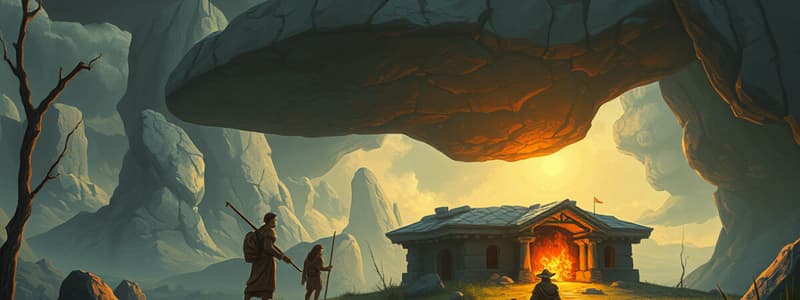Podcast
Questions and Answers
What is the period of time known as Prehistory?
What is the period of time known as Prehistory?
The period from the appearance of the first human being to the invention of writing.
Which of the following are characteristics of the Paleolithic age? (Select all that apply)
Which of the following are characteristics of the Paleolithic age? (Select all that apply)
- Invented fire (correct)
- Farming
- Sedentary living
- Nomadic lifestyle (correct)
In the Neolithic age, people learned to grow food and domesticate animals.
In the Neolithic age, people learned to grow food and domesticate animals.
True (A)
What was the first metal used by humans?
What was the first metal used by humans?
What period followed the Bronze Age in historical categorization?
What period followed the Bronze Age in historical categorization?
Define a civilization.
Define a civilization.
What was a key feature of the ancient Egyptian houses?
What was a key feature of the ancient Egyptian houses?
Which of the following was a significant aspect of Greek culture?
Which of the following was a significant aspect of Greek culture?
What subjects did Roman students study?
What subjects did Roman students study?
What does the term 'Middle Ages' refer to?
What does the term 'Middle Ages' refer to?
Flashcards are hidden until you start studying
Study Notes
Prehistory
- Lasted from 3 million years ago to 3,000 B.C., marked by the absence of written documents.
- Understanding derived from material remains: human bodies, tools, art, and sculptures.
Stone Age
-
Paleolithic Era:
- Characterized by nomadic lifestyles; people lived in caves.
- Engaged in hunting and gathering; invented fire.
- Clothing made from animal fur.
-
Neolithic Era:
- Emergence of agriculture and domestication of animals.
- Transition to sedentary living with permanent homes made from wood or bricks.
- Development of clothing through knitting.
Metal Age
-
Marked by the introduction of metal tools alongside stone tools.
-
Copper: believed to be the first metal used by humans.
-
Bronze Age:
- Regular use of bronze for tools and weapons; significant for artistic creation.
-
Iron Age:
- Key focus on iron, which is stronger, more durable, and sharper than bronze.
- Marked the foundation for modern industry.
Ancient History
- Began with the invention of writing; emergence of civilizations like Egyptians, Greeks, and Romans.
- Civilizations characterized by organization, culture, and territory.
- Formation of governments and trade systems; introduction of coins as currency.
- Archaeologists utilize artifacts to understand ancient societies and their monumental constructions (e.g. Pyramids, Parthenon).
Egyptian Society
- Dependent on the Nile River, with houses built from mud-bricks.
- Wealthy Egyptians lived in luxurious homes with gardens, often maintained by servants.
- Enjoyed storytelling, music, and large public festivals honoring gods like Osiris.
Greek Society
- Known for inventions in philosophy, art, and architecture.
- Public games and athletic events led to the establishment of the Olympic Games.
- Utilized a new alphabet, influencing modern writing systems.
- Established a democratic government structure.
Roman Society
- Education considered important; subjects included math with a unique numeral system (I, V, X, L, C, M).
- Daily life involved a division of labor, with males working and females managing households.
- Olive oil lamps were common for lighting during nighttime.
The Middle Ages
- Span from 400 to 1500 AD, framing the period between the Roman Empire's fall and the Renaissance.
- Divided into Early, High, and Late Middle Ages.
- Period marked by conflicts against the Islamic Empire, notably centered around the Eastern Mediterranean and Jerusalem for religious reasons.
Studying That Suits You
Use AI to generate personalized quizzes and flashcards to suit your learning preferences.




